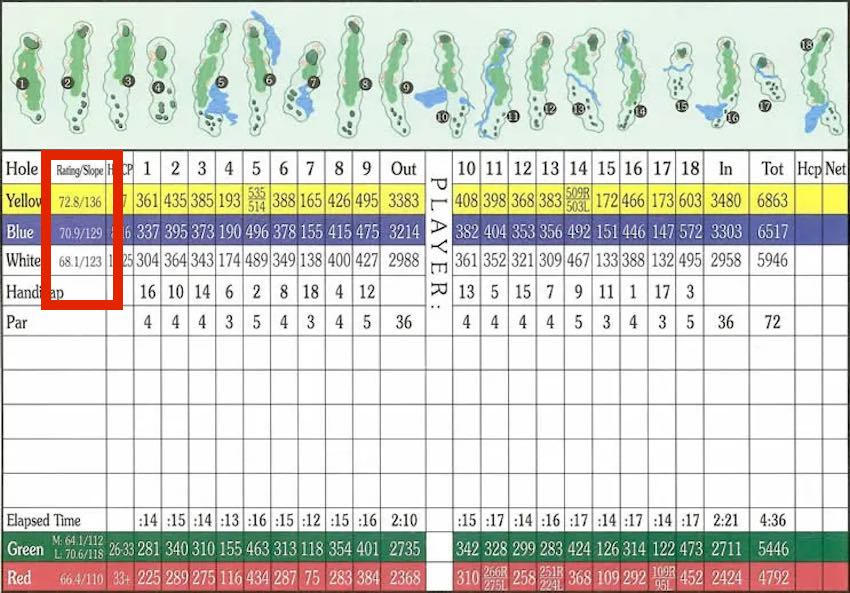Are you an avid golfer looking to improve your game and compete fairly with players of varying skill levels? Understanding how to calculate a golfers handicap is essential to achieving that goal.
In this comprehensive guide, we’ll walk you through the golf handicap system, its importance, and how to accurately calculate your handicap for both 18-hole and 9-hole rounds. Let’s get started!
Short Summary
Golf handicaps are numerical measures of a golfer’s potential skill to ensure fair competition.
The World Handicap System (WHS) provides a unified measure of golfers’ abilities and promotes fairness across different courses worldwide.
Calculating your golf handicap requires understanding components such as the Handicap Index, Course Rating, Slope Rating and Adjusted Gross Score. There are various tools available for assistance with this process.
Understanding Golf Handicap

A golf handicap is a numerical representation of a golfer’s potential skill, ensuring fair competition by balancing the disparity between your score and the scores of other players on various golf courses.
Introduced over a century ago, the handicap system was designed to calculate the number of strokes one party should concede to the other on a particular course, guaranteeing equitable competition.
But how exactly is a golf handicap calculated? The process involves several key components, including Handicap Index, Course Handicap, Adjusted Gross Score, Slope Rating, and Course Rating.
In the following sections, we’ll delve deeper into the importance of golf handicap, the difference between Handicap Index and Course Handicap, and the World Handicap System (WHS), which was introduced in 2020 to improve and standardize handicap calculation globally.
Related – Test your golf knowledge with over 100 trivia questions
The Importance of Golf Handicap
The primary objective of a golf handicap is to equalize competition between golfers of diverse ability levels, ensuring a level playing field.
Being aware of your handicap allows you to understand your own capabilities and fosters a sense of competition in the game. It’s essential to know how to calculate your golf handicap accurately to ensure you’re competing fairly with players of various skill levels.
Calculating your Handicap Index
A handicap index is obtained by finding your score differentials from your last 20 rounds. You simply take the 8 best differentials and take the average of those 8.
To calculate a handicap differential score, one must subtract the Course Rating from the player’s Adjusted Gross Score, then multiply the result by 113 and divide by the slope rating.
(113 / Slope Rating) x (Adjusted Gross Score – Course Rating)
It’s essential to round off the results to the nearest whole number to obtain an accurate Course Handicap and understand the impact of handicap differentials.
By applying this formula and understanding the various components involved, you can accurately calculate your golf handicap and ensure fair competition in the game.
Handicap Index vs. Course Handicap
The Handicap Index and Course Handicap are two crucial concepts in calculating a golfer’s handicap. The Handicap Index is a golfer’s general average performance, while the Course Handicap represents the number of strokes a golfer is permitted on a particular course based on their Handicap Index and the Course Rating.
To calculate the Course Handicap, you’ll need to multiply the Handicap Index by the Slope Rating, divide by 113, and then add the difference between the Course Rating and Par. It’s important to round off the result to the nearest whole number to obtain an accurate Course Handicap.
For example, if I have a current handicap index of 11.2 and I am playing on a par 70 course with a slope rating of 117 and a course rating of 65.4, my course handicap would be a 7.
(11.2 * 117)/113 = 11.59
65.4 – 70 = -4.6
11.59 + (-4.6) = 6.99 (rounded up to the nearest whole number is 7)
USGA has a really simple Course Handicap Calculator.
Not sure what slope rating and course rating are? I explain the golf scorecard, including these terms, in more depth here.
The World Handicap System (WHS)

The World Handicap System (WHS) was established by The R&A and USGA to provide a more unified measure of players’ abilities and integrate the game of golf under a single set of handicapping rules. The WHS introduced several key changes to the golf handicap calculation, such as incorporating fewer scores, daily updates, a cap of net double bogey, and the ability to adjust for playing conditions.
These changes aimed to ensure that golfers’ handicaps remain an accurate representation of their demonstrated ability and foster fair competition across various golf courses, including the local golf course, worldwide.
Let’s take a closer look at the formation and purpose of the WHS, along with the key changes it brought to the golf handicap calculation process.
WHS Formation and Purpose
The World Handicap System (WHS) was developed by the USGA, R&A, and other golf associations to provide a consistent and fair way of measuring a golfer’s ability. The primary alterations to the golf handicap calculation under the WHS involve the modification of the formula for computing a handicap index, the utilization of course handicap to modify individual hole scores, and the computation of a handicap index based on the best 8 of the player’s most recent 20 scores.
The goal of the WHS is to offer a more uniform measure of players’ competencies and integrate the game of golf under a single set of handicapping regulations, ensuring fair play and competition for golfers of varying skill levels.
Key Changes in Golf Handicap Calculation
The primary modifications to golf handicap calculation under the WHS include a decrease in the number of scores utilized, daily updates, a net double bogey as the maximum score, and an adjustment for playing conditions.
These changes allow for more accurate and up-to-date handicaps, accounting for varying course conditions and ensuring fair competition among golfers. Additionally, the Playing Conditions Calculation (PCC) was implemented as a new factor that accounts for factors such as weather or course setup, which cannot be calculated by the player.
Calculating Your Golf Handicap

Calculating your golf handicap involves using the Adjusted Gross Score, Slope Rating, and Course Rating, along with the handicap calculation formula. To determine your Handicap Index, an average of your golf round scores is calculated by summing the differentials and dividing them by the number of differentials used, then multiplying the result by 0.96.
Required Scores and Adjusted Gross Score
To calculate a handicap index, a minimum of 5 18-hole scores or 10 9-hole scores is needed, although up to 20 scores can be used. The Adjusted Gross Score (AGS) is derived by subtracting the Course Rating from the handicap score.
Moreover, the Equitable Stroke Control (ESC) is employed as a maximum number of strokes that a golfer is permitted to enter in any given hole, ensuring fairness in the handicap calculation process. For example, if a player with a Course Handicap of 18 records a 9 on a hole, the 9 should be adjusted to 7.
ESC prevents a total blowup hole from skewing the numbers. Imagine attacking a hole tin-cup style and turning in a 12. That’s really not an accurate reflection of your ability.
Utilizing Slope Rating and Course Rating
Slope Rating and Course Rating play a pivotal role in calculating your golf handicap. Course Rating is the estimated number of strokes a professional “scratch” player requires to complete the course, taking into account the difficulty of the course. A course’s slope rating, on the other hand, is a measure of the disparity in difficulty between a high handicapper and a low handicapper. A higher slope rating implies a more challenging course for the average golfer.
Understanding these two ratings and how they relate to course difficulty is crucial for accurately calculating your golf handicap, as they are used in the handicap calculation formula to account for the specific challenges of the course you’re playing.
Tools and Resources for Calculating Golf Handicap
In addition to understanding the principles of golf handicap calculation, there are several tools and resources available to help you calculate your golf handicap with ease. These include online calculators and apps, club officials, and handicap committees.
Online Calculators and Apps
Digital tools, such as online calculators and apps, can be incredibly helpful in calculating your golf handicap quickly and accurately. Examples of available online calculators and apps include those provided on websites such as USGA.org and golfhandicapcalculator.net, as well as free apps like Simple Handicap.
Utilizing online calculators and apps for golf handicap can assist golfers in saving time and effort in computing their handicap, offering more precise results than manual calculations. By leveraging these digital tools, you can focus on improving your game and competing fairly with players of various skill levels.
Club Officials and Handicap Committees
Club officials, particularly the Handicap Committee, play a significant role in implementing the Rules of Handicapping at the local level, ensuring adherence to the golf club’s stipulated duties and responsibilities. The Handicap Committee is tasked with ensuring that each player’s Handicap Index remains an accurate representation of their demonstrated ability.
By seeking assistance from club officials and handicap committees, you can ensure that your golf handicap is calculated accurately and in accordance with the rules and regulations set forth by the golf club and governing bodies.
Golf Handicap for 9-Hole Rounds

For golfers who prefer playing 9-hole rounds, calculating a 9-hole handicap is essential. To do so, you’ll need to divide the Course and Slope ratings by two and use the Score Differential formula for averaging two scores, just as you would for an 18-hole round.
It’s important to note that the maximum allowable handicap index for men on a 9-hole course is 18.2 and for women, it’s 20.2. By understanding the process of calculating a 9-hole handicap, you can ensure fair competition regardless of the number of holes played.
Common Misconceptions About Golf Handicaps
There are several misconceptions about golf handicaps that can lead to confusion and misunderstandings. For instance, one common myth is that a golfer’s handicap is indicative of their average score, when in fact, it is merely a measure of their potential ability.
Another misconception is that a golfer should be able to shoot their handicap each time, when in reality, it is a representation over a period of time with varying scores and potentially on courses of varying difficulty.
Tips for Improving Your Golf Handicap
Improving your golf handicap requires patience, dedication, and a focus on identifying and correcting issues in your swing and overall approach to the game. In addition to practicing regularly, attention to the short game, professional coaching, and strength training workouts can all contribute to improved performance on the course.
Moreover, developing a consistent pre-shot routine, focusing on 2-putting from 11ft to 30ft, and avoiding penalty strokes can help you lower your handicap, enhance your overall golfing experience. With enough dedication, possibly even becoming a scratch golfer.
Related – Best Pre-Shot golf Routine
By applying these tips and consistently working on your game, you can gradually improve your golf handicap and enjoy fair competition with players of varying skill levels.
Summary
In conclusion, understanding how to calculate your golf handicap is crucial for ensuring fair competition among golfers of diverse abilities.
By familiarizing yourself with the concepts of Handicap Index, Course Handicap, Adjusted Gross Score, Slope Rating, and Course Rating, as well as the World Handicap System and its key changes, you can accurately calculate your handicap for both 18-hole and 9-hole rounds.
Leveraging available tools and resources, such as online calculators and apps, and seeking assistance from club officials and handicap committees, can further streamline the process.
Armed with this knowledge, you are well-equipped to improve your golf handicap and enjoy a more competitive and rewarding golfing experience.
